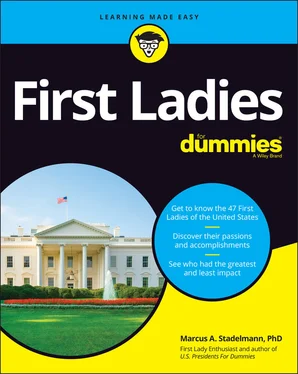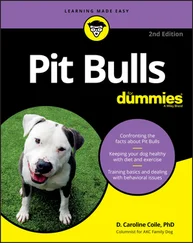Unlike U.S. presidents, academics and the American public rarely evaluate First Ladies. It wasn’t until the 1980s that the Siena College Research Institute in New York established an academic survey to rate and rank First Ladies. The survey continues but isn’t taken often, usually only about once a decade. To this date, it has been conducted only five times since its inception in 1982. The most recent survey, discussed later in the chapter, was taken in 2014.
 Keep in mind that times change and First Lady rankings reflect this. Early in U.S. history, First Ladies were mainly hostesses in and caretakers of the White House. Some even refused to do that and had their daughters step into their place. Only a few First Ladies mattered when it came to impacting policy making. They were Sarah Polk, Dolley Madison, and, of course, Abigail Adams. Not surprisingly, many First Ladies of the 19th century don’t rank very high in the survey. They just didn’t do much besides being a great White House hostess, if that. Keep in mind that this isn’t a negative thing; that is all that was expected of them, and if they had been more engaged, the American public may not have stood for it.
Keep in mind that times change and First Lady rankings reflect this. Early in U.S. history, First Ladies were mainly hostesses in and caretakers of the White House. Some even refused to do that and had their daughters step into their place. Only a few First Ladies mattered when it came to impacting policy making. They were Sarah Polk, Dolley Madison, and, of course, Abigail Adams. Not surprisingly, many First Ladies of the 19th century don’t rank very high in the survey. They just didn’t do much besides being a great White House hostess, if that. Keep in mind that this isn’t a negative thing; that is all that was expected of them, and if they had been more engaged, the American public may not have stood for it.
It wasn’t until the 20th century that stronger First Ladies emerged. They suddenly took their place next to the president and influenced policy making. Some were even quite public about it. Eleanor Roosevelt was the first First Lady who was actually publicly involved in policy making and openly conversed with the America public about her political stands and preferences.
Media scrutiny of First Ladies is also a recent phenomenon. During most of the 19th and 20th centuries, the media didn’t delve into the lives of First Ladies. Much of what we know, we get from letters written by First Ladies, their husbands, and their acquaintances, and even that isn’t much because often First Ladies would burn their correspondence when leaving office. It was considered taboo to report on the private lives of First Ladies — the public didn’t know much, if anything, about Eleanor Roosevelt’s live-in girlfriend or Helen Taft smoking cigarettes and playing cards with the boys. A president’s or First Lady’s private indiscretions were kept secret. This code of silence held well into the 20th century.
The Watergate scandal in the 1970s changed things. Suddenly, the media believed that it had an obligation to be a watchdog over the presidents and First Ladies. This new role allowed the media not only to check presidents for public mistakes and policy failures but also to report on First Ladies and their activities. This role for the media won’t change as long as juicy scandals continue to garner large audiences. Future First Ladies have to expect to have their lives scrutinized and any minor wrongdoing reported. Hillary Clinton found that out the hard way in 1993 with the Whitewater scandal, where the Clinton’s were accused of financial wrongdoings (see Chapter 18) and again in 2015, after her term as First Lady had ended in 2001, when the media reported on her using her private server for classified emails. Today, scrutiny of First Ladies does not even end after their terms have ended. Melania Trump ran into a similar problem when her nude photoshoot of 2000 was revealed during the 2016 campaign.
Ranking U.S. First Ladies
One of the best academic evaluations of U.S. First Ladies was released in 2014, in a joint effort by both the Siena College Research Institute and C-SPAN (National Cable Satellite Corporation), a network created to show public affairs programming. The survey was conducted in 2013, and its results were released in 2014. A total of 242 experts on First Ladies in the United States were asked to rank the First Ladies based on ten criteria (see the section “ Discussing ten evaluation criteria”). Rankings of all the First Ladies are rare, they are-time consuming, expensive, and there isn’t much demand for them.
Note: Because the study was done in 2013–2014, it obviously doesn’t include either Melania Trump or Dr. Jill Biden, who became First Lady in 2017 and 2021, respectively. It further excludes Harriet Lane, who was President Buchanan’s niece and became his First Lady because he was a lifelong bachelor. I and many other academics do count her as a First Lady, and in Chapter 21, she is among my choices for the ten most influential First Ladies. Finally, the study excludes the four First Ladies who died before their husbands became president and Anna Harrison who never had a chance to became First Lady after her husband died a month into office.
The Siena Research Institute Survey
 The Siena Research Institute Survey was the first survey on First Ladies in the United States. It’s conducted about every ten years, and it asks history and political science professors at American universities, as well as other experts on First Ladies, to rank the U.S. First Ladies on a scale of one to five based on ten separate categories (see the section “ Discussing ten evaluation criteria”). Unlike surveys on American presidents, there were no other surveys to compare results to and thus the Siena College Research Institutes findings are the only comprehensive survey on U.S. First Ladies, establishing a benchmark for First Lady studies. Table 2-1presents its rankings in order.
The Siena Research Institute Survey was the first survey on First Ladies in the United States. It’s conducted about every ten years, and it asks history and political science professors at American universities, as well as other experts on First Ladies, to rank the U.S. First Ladies on a scale of one to five based on ten separate categories (see the section “ Discussing ten evaluation criteria”). Unlike surveys on American presidents, there were no other surveys to compare results to and thus the Siena College Research Institutes findings are the only comprehensive survey on U.S. First Ladies, establishing a benchmark for First Lady studies. Table 2-1presents its rankings in order.
TABLE 2-1First Lady Rankings
| Ranking |
C-SPAN Academic Survey |
| 1 |
Eleanor Roosevelt |
| 2 |
Abigail Adams |
| 3 |
Jaqueline Kennedy |
| 4 |
Dolley Madison |
| 5 |
Michelle Obama |
| 6 |
Hillary Clinton |
| 7 |
Lady Bird Johnson |
| 8 |
Betty Ford |
| 9 |
Martha Washington |
| 10 |
Rosalynn Carter |
| 11 |
Barbara Bush |
| 12 |
Laura Bush |
| 13 |
Edith Roosevelt |
| 14 |
Edith Wilson |
| 15 |
Nancy Reagan |
| 16 |
Bess Truman |
| 17 |
Lou Hoover |
| 18 |
Louisa Adams |
| 19 |
Ellen Wilson |
| 20 |
Lucy Hayes |
| 21 |
Grace Coolidge |
| 22 |
Julia Grant |
| 23 |
Sarah Polk |
| 24 |
Mamie Eisenhower |
| 25 |
Helen Taft |
| 26 |
Francis Cleveland |
| 27 |
Julia Tyler |
| 28 |
Lucretia Garfield |
| 29 |
Caroline Harrison |
| 30 |
Elizabeth Monroe |
| 31 |
Mary Lincoln |
| 32 |
Abigail Fillmore |
| 33 |
Pat Nixon |
| 34 |
Ida McKinley |
| 35 |
Margaret Taylor |
| 36 |
Florence Harding |
| 37 |
Letitia Tyler |
| 38 |
Eliza Johnson |
| 39 |
Jane Pierce |
Source: Siena College Research Institute/C-Span study of the first ladies of the United States, 2014. Retrieved at: https://scri.siena.edu/first-ladies-study/
If you compare the results from the first survey taken in 1982 to the last one, conducted in 2014, the top ten and bottom ten First Ladies have been fairly consistent. At the bottom are Jane Pierce, Eliza Johnson, Letitia Tyler, and Florence Harding. Even Mary Lincoln falls into the bottom ten category. Mary Lincoln and Jane Pierce are considered neurotic women whose behavior and attitude made their husband’s life more difficult. Instead of being helpful during their husbands’ presidencies, they did the exact opposite and undermined their husband’s reputation and proved to be a handicap for effective policy making. Florence Harding is often blamed for being too ambitious and pushing her unqualified husband to become president. He turned out to be one of the worst presidents in American history. Letitia Tyler and Eliza Johnson, on the other hand, had no interest in being First Lady. Both claimed to be ill and made their daughters surrogate First Ladies for their husbands.
Читать дальше

 Keep in mind that times change and First Lady rankings reflect this. Early in U.S. history, First Ladies were mainly hostesses in and caretakers of the White House. Some even refused to do that and had their daughters step into their place. Only a few First Ladies mattered when it came to impacting policy making. They were Sarah Polk, Dolley Madison, and, of course, Abigail Adams. Not surprisingly, many First Ladies of the 19th century don’t rank very high in the survey. They just didn’t do much besides being a great White House hostess, if that. Keep in mind that this isn’t a negative thing; that is all that was expected of them, and if they had been more engaged, the American public may not have stood for it.
Keep in mind that times change and First Lady rankings reflect this. Early in U.S. history, First Ladies were mainly hostesses in and caretakers of the White House. Some even refused to do that and had their daughters step into their place. Only a few First Ladies mattered when it came to impacting policy making. They were Sarah Polk, Dolley Madison, and, of course, Abigail Adams. Not surprisingly, many First Ladies of the 19th century don’t rank very high in the survey. They just didn’t do much besides being a great White House hostess, if that. Keep in mind that this isn’t a negative thing; that is all that was expected of them, and if they had been more engaged, the American public may not have stood for it.










